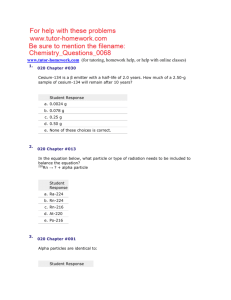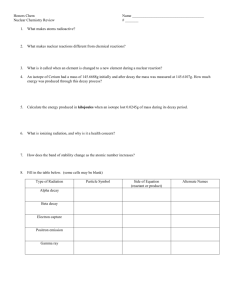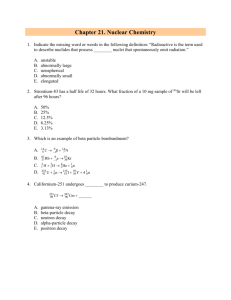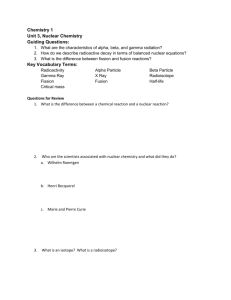What particle is formed when polonium
advertisement
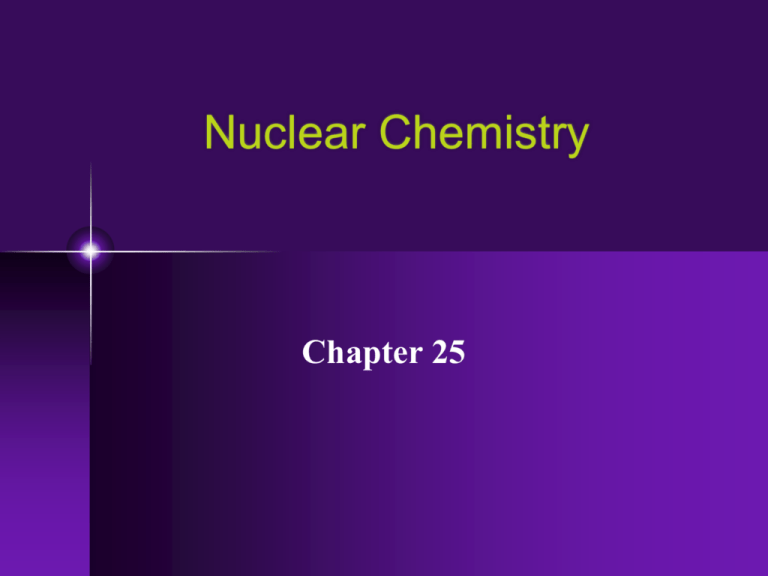
Nuclear Chemistry Chapter 25 Nuclear Radiation Section 25.1 Nuclear Reactions 1. Occur when nuclei emit particles and/or rays. 2. Atoms are often converted into atoms of another element. 3. May involve protons, neutrons, and electrons 4. Associated with large energy changes. 5. Reaction rate is not normally affected by temperature, pressure, or catalysts. Wilhelm Roentgen • 1845-1923 1895: When electrons bombarded surface of certain materials, invisible rays were emitted Henri Becquerel • 1852-1908 studied minerals that when exposed to sunlight, emit light phosphorescence discovered uranium salts (pitchblende) Marie Curie • 1867-1934 Marie & Pierre Curie isolated components emitting rays identifed Po & Ra MORE HISTORY Rutherford (1871-1937) identified alpha, beta, and gamma radiation PROPERTIES OF RADIATION 1. 2. 3. Alpha () 4 He, helium nuclei 2 Blocked by paper; 6.64 x 10-24 kg Slow moving due to mass and charge! Beta () 0 or 0 e, electrons -1 -1 Blocked by metal foil; 9.11 x 10-28 kg Fast moving Emitted from a neutron of an unstable nucleus Insignificant mass compared with mass of nucleus Greater penetrating power than alpha particles Gamma () 0 , photons 0 Not completely blocked by lead or concrete; 0 kg High energy electromagnetic radiation Almost always accompanies alpha and beta radiation Radioactive Decay Section 25.2 NUCLEAR STABILITY • Correlated with atom’s neutron-toproton ratio. • < 20 atomic number most stable BETA DECAY • Instability of isotope due to too many neutrons relative to its number of protons. ALPHA DECAY • All nuclei with more than 83 protons decay spontaneously POSITRON EMISSION • Positron is a particle with the same mass as an electron but the opposite charge • 01 or 01e • During emission, a proton in the nucleus is converted to a neutron and a positron • 1 1p --> 1 0n + 01 ELECTRON CAPTURE • Nucleus of an atom draws in a surrounding electron (from lowest energy level) • Captured electron combines with a proton to form a neutron • 1 1p + 0-1e --> 1 0n PROBLEM What particle is formed when polonium-210 undergoes alpha decay? PROBLEM What particle is formed when polonium-210 undergoes alpha decay? 210 Po 84 --> mass atomic #Po PROBLEM What particle is formed when polonium-210 undergoes alpha decay? 210 Po 84 --> 4 He 2 + PROBLEM What particle is formed when polonium-210 undergoes alpha decay? 210 Po 84 --> 4 He 2 + 206 How did I get 20682 ? 82 ? PROBLEM What particle is formed when polonium-210 undergoes alpha decay? 210 Po 84 --> 4 He 2 + 206 82 ? How did I get 20682 ? The numbers must add up the same on both sides of the equation (top #’s =, and bottom #’s =) PROBLEM What particle is formed when polonium-210 undergoes alpha decay? 210 Po 84 --> 4 He 2 + 206 82 ? How do you determine the element? By atomic number! PROBLEM What particle is formed when polonium-210 undergoes alpha decay? 210 Po 84 --> 4 He 2 + 206 82 Pb How do you determine the element? By atomic number! PROBLEM What would the decay process of iodine131 into xenon-131 look like? PROBLEM What would the decay process of iodine131 into xenon-131 look like? 131 I 53 --> 131 Xe 54 + ? PROBLEM What would the decay process of iodine131 into xenon-131 look like? 131 I 53 --> 131 Xe 54 + 0 -1? What type of radiation: 0-1? PROBLEM What would the decay process of iodine131 into xenon-131 look like? 131 I 53 --> 131 Xe 54 + 0 -1 What type of radiation: 0-1? Beta! RADIOACTIVE SERIES • A series of nuclear reactions that begins with an unstable nucleus and results in the formation of a stable nucleus. TRANSMUTATION Section 25.3 TRANSMUTATION • Conversion of an atom of one element to an atom of another element • In all but gamma emission nuclear reactions INDUCED TRANSMUTATION • Striking nuclei with high-velocity charged particles • Must be moving at high speeds to overcome electrostatic repulsion of target atom’s nucleus • Use particle accelerators (“atom smashers” TRANSURANIUM ELEMENTS • Elements immediately following uranium in the periodic table • Atomic number of 93 or greater • Developed in the laboratory by induced transmutation • Radioactive PROBLEM Write a balanced nuclear equation for the induced transmutation of aluminum-27 into phosphorus-30 by alpha particle bombardment. A neutron is emitted from the aluminum atom in the reaction. PROBLEM Write a balanced nuclear equation for the induced transmutation of aluminum-27 into phosphorus-30 by alpha particle bombardment. A neutron is emitted from the aluminum atom in the reaction. Write all symbols on proper sides of the equation. Make certain numbers add up! PROBLEM Write a balanced nuclear equation for the induced transmutation of aluminum-27 into phosphorus-30 by alpha particle bombardment. A neutron is emitted from the aluminum atom in the reaction. Write all symbols on proper sides of the equation. Make certain numbers add up! 27 Al 13 + 4 2He ---> 1 0n + 30 15P PROBLEM Write a balanced nuclear equation for the induced transmutation of aluminum-27 into phosphorus-30 by alpha particle bombardment. A neutron is emitted from the aluminum atom in the reaction. 27 Al 13 + 4 2He ---> 1 0n + 30 15P How did I know the symbol for a neutron? A neutron has mass but no nuclear charge! HALF-LIFE • Time required for one-half of a radioisotope’s nuclei to decay into its products. • Exponential decay! • Strontium-90 has a half-life of 29 years. • So, if you had 10 g of this, in 29 years you would have 5 grams left. HALF-LIFE Amount remaining = (initial amount)(1/2)n n is equal to the number of half lives that has passed OR Amount remaining = (initial amount)(1/2)T/t 1/2 T is equal to the elapsed time and t 1/2 is the duration of the half-life PROBLEM Iron-59 is used in medicine to diagnose blood circulation disorders. The half-life of iron-59 is 44.5 days. How much of a 2.000 mg sample will remain after 133.5 days? PROBLEM Iron-59 is used in medicine to diagnose blood circulation disorders. The half-life of iron-59 is 44.5 days. How much of a 2.000 mg sample will remain after 133.5 days? Amount remaining = (initial amount)(1/2)n X = 2.000 (1/2)133.5/44.5 PROBLEM Iron-59 is used in medicine to diagnose blood circulation disorders. The half-life of iron-59 is 44.5 days. How much of a 2,000 mg sample will remain after 133.5 days? Amount remaining = (initial amount)(1/2)n X = 2.000 (1/2)133.5/44.5 Amount remaining = 0.2500 mg RADIOCHEMICAL DATING • Process of determining an age of an object by measuring the amount of a certain radioisotope remaining in that object • Uranium • Half-life of 4.5 c 109 years • Meteorites; have estimated age of solar system at 4.6 x 109 years • Carbon dating • 146C ---> 147N + 0-1 • Half-life of 5730 years • Limited to accurately dating objects up to 24,000 years of age Fission and Fusion of Atomic Nuclei Section 25.4 ∆E = ∆ mc2 • I lied! (kind of…) • For most practical situations, mass is conserved, but… • Energy and mass can be converted into each other! • It has been determined that the mass of the nucleus is always less than the sum of the masses of the individual protons and neutrons that comprise it. (CALLED MASS DEFECT) • The missing mass provides tremendous energy required to bind the nucleus together. NUCLEAR FISSION • Heavier atoms (mass # > 60) tend to fragment into smaller atoms to increase their stability • This is accompanied by a very large release of energy NUCLEAR POWER PLANTS • Use fission to generate power • UO2 encased in corrosion-resistant fuel rods • Enriched to contain 3% uranium-235 (meets critical mass to sustain the chain reaction) • Control rods of cadmium or boron absorb neutrons released during the reaction, controlling the fission process • Water circulates throughout the core to carry off the heat generated • This is used to power stream driven turbines which produce electrical power • Dense concrete structure encloses the reactor NUCLEAR POWER PLANTS • Drawbacks • Hazardous radioactive fuels and fission products • Limited supply of uranium-235 • Where to store spent fuel rods? • Require 20 half-lives to decay to safe levels Amount of spent fuel for a lifetime/person would equal the size of a basketball NUCLEAR FUSION • Binding together two light (mass # < 60) and less stable nuclei • Capable of releasing very large amounts of energy • The sun! • Requires temperatures of 40,000,000 K! • Can achieve this by atomic explosion (not safe!) • Don’t have materials capable of withstanding these high temperatures ATOMIC BOMB • Utilizes principles of fission (uncontrolled!) • Equal to effect of 20,000 tons of TNT HYDROGEN BOMB • Never used in warfare • Explosive force 1000 X greater than atomic bomb Fission reaction triggers a fusion reaction of hydrogen isotopes (deuterium and tritium) Equal to 15 million tons of TNT IONIZING RADIATION • Radiation energetic enough to ionize matter with which it collides • Detected by: • Geiger counter • Metal tube filled with a gas; gets ionized; creates an electrical current • Scintillation counter • Radiation energizes a phosphorcoated surface that releases bright flashes USES OF RADIATION • Neutron activation analysis • Determine quality of silicon wafers used in computers • Radiotracers • Trace biological pathways • PET • Imagery used in medical diagnoses • Radiation to kill cancer cells • Irradiation of meats, fruits…
